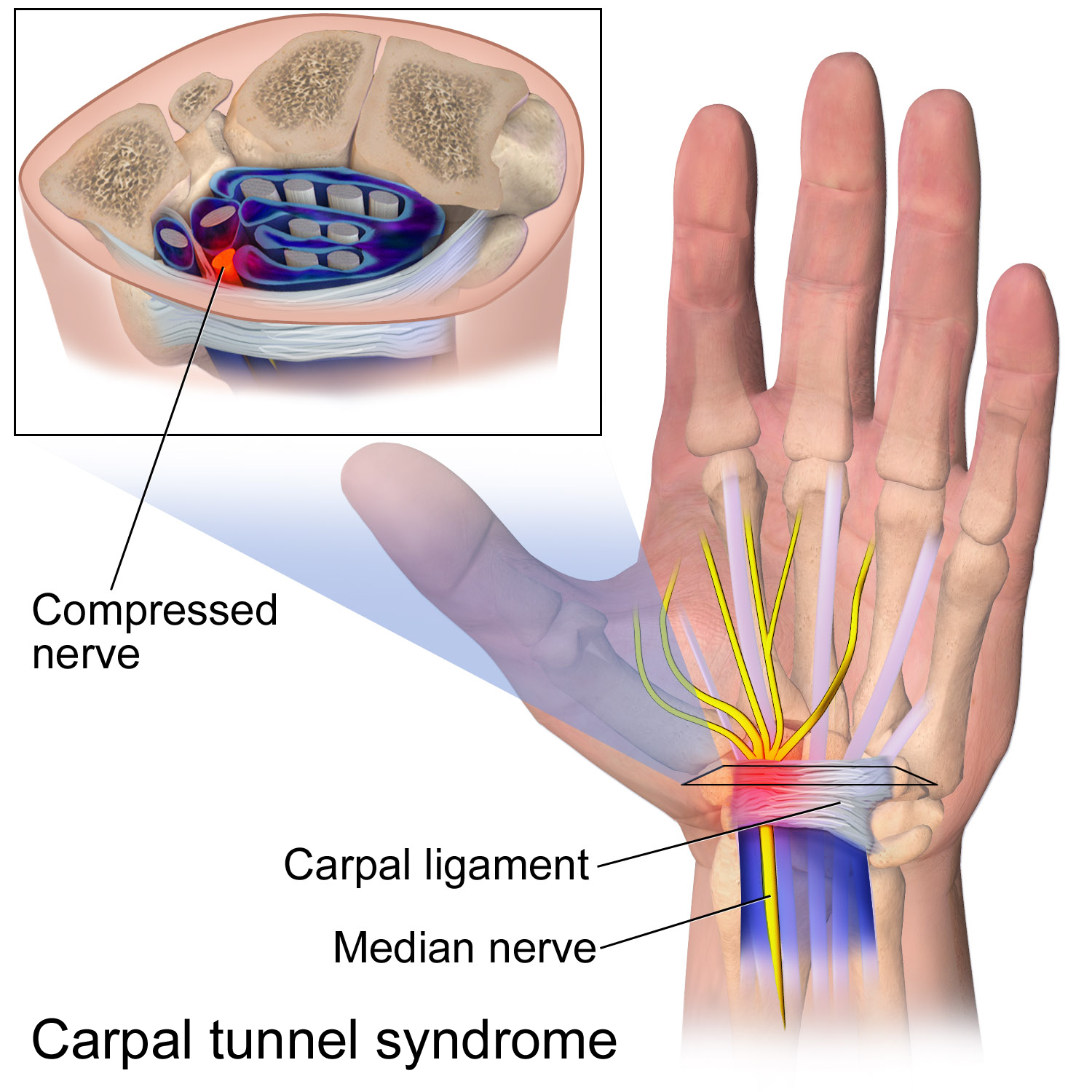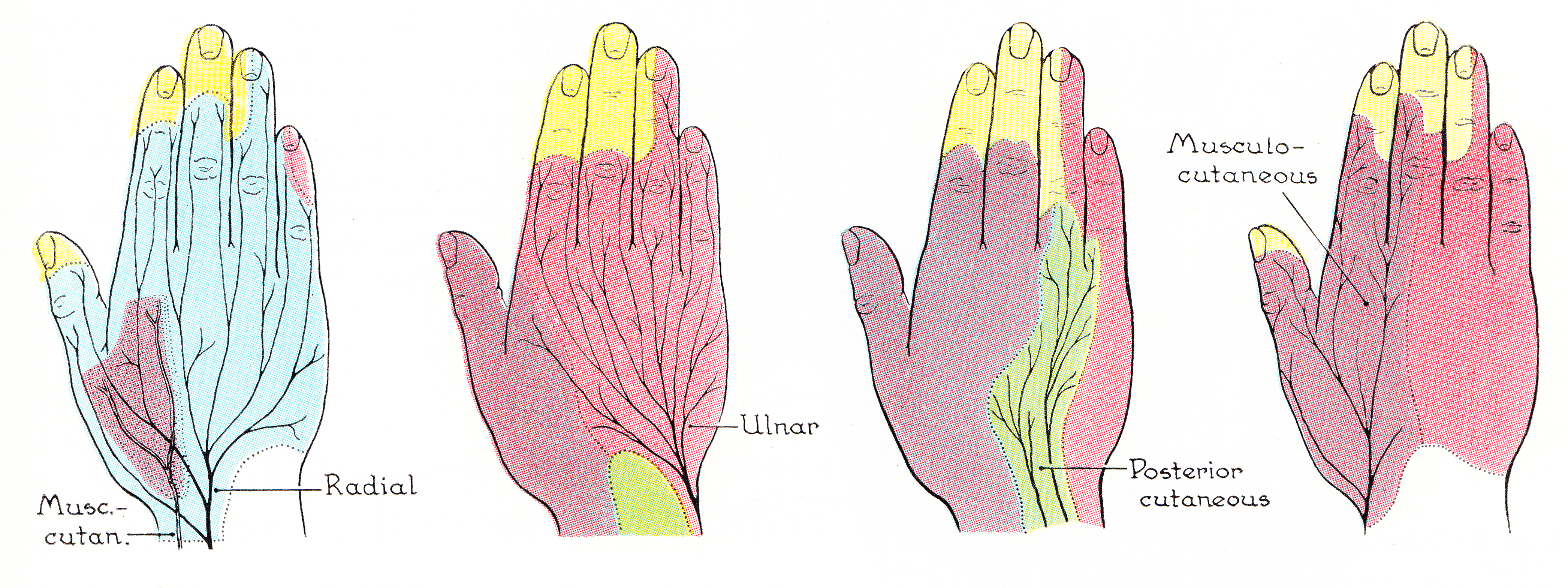|
Phalen's Test
Phalen's maneuver is a diagnostic test for carpal tunnel syndrome by an American orthopedist named George S. Phalen. Technique The patient is asked to hold their wrists in complete and forced flexion (pushing the dorsal surfaces of both hands together) for 30–60 seconds. The lumbricals attach in part to the flexor digitorum profundus tendons. As the wrists flex, the flexor digitorum profundus contracts in a proximal direction, drawing the lumbricals along with it. In some individuals, the lumbricals can be "dragged" into the carpal tunnel with flexor digitorum profundus contraction. As such, Phalen's maneuver can moderately increase the pressure in the carpal tunnel via this mass effect, pinching the median nerve between the proximal edge of the transverse carpal ligament and the anterior border of the distal end of the radius. By compressing the median nerve within the carpal tunnel, characteristic symptoms Signs and symptoms are diagnostic indications of an i ... [...More Info...] [...Related Items...] OR: [Wikipedia] [Google] [Baidu] |
Radius (bone)
The radius or radial bone (: radii or radiuses) is one of the two large bones of the forearm, the other being the ulna. It extends from the Anatomical terms of location, lateral side of the Elbow-joint, elbow to the thumb side of the wrist and runs parallel to the ulna. The ulna is longer than the radius, but the radius is thicker. The radius is a long bone, Prism (geometry), prism-shaped and slightly curved longitudinally. The radius is part of two joint (anatomy), joints: the elbow and the wrist. At the elbow, it joins with the capitulum of the humerus, and in a separate region, with the ulna at the radial notch. At the wrist, the radius forms a joint with the ulna bone. The corresponding bone in the human leg, lower leg is the tibia. Structure The long narrow medullary cavity is enclosed in a strong wall of compact bone. It is thickest along the interosseous border and thinnest at the extremities, same over the cup-shaped articular surface (fovea) of the head. The tra ... [...More Info...] [...Related Items...] OR: [Wikipedia] [Google] [Baidu] |
Tinel's Sign
Tinel's sign (also Hoffmann-Tinel sign) is a way to detect irritated nerves. It is performed by lightly tapping ( percussing) over the nerve to elicit a sensation of tingling or "pins and needles" in the distribution of the nerve. Percussion is usually performed moving distal to proximal. It is named after Jules Tinel.Tinel, J. (1978) The "tingling sign" in peripheral nerve lesions (Translated by EB Kaplan). In: M. Spinner M (Ed.), Injuries to the Ma jor Branches of Peripheral Nerves of the Forearm. (2nd ed.) (pp 8–13). Philadelphia: WD Saunders CoTinel, J. (1915) Le signe du fourmillement dans les lésions des nerfs périphériques. Presse médicale, 47, 388–389Tinel, J., Nerve wounds. London: Baillère, Tindall and Cox, 1917 It is a potential sign of carpal tunnel syndrome Carpal tunnel syndrome (CTS) is a nerve compression syndrome associated with the collected signs and symptoms of Pathophysiology of nerve entrapment#Compression, compression of the median nerve at ... [...More Info...] [...Related Items...] OR: [Wikipedia] [Google] [Baidu] |
Sensitivity (tests)
In medicine and statistics, sensitivity and specificity mathematically describe the accuracy of a test that reports the presence or absence of a medical condition. If individuals who have the condition are considered "positive" and those who do not are considered "negative", then sensitivity is a measure of how well a test can identify true positives and specificity is a measure of how well a test can identify true negatives: * Sensitivity (true positive rate) is the probability of a positive test result, conditioned on the individual truly being positive. * Specificity (true negative rate) is the probability of a negative test result, conditioned on the individual truly being negative. If the true status of the condition cannot be known, sensitivity and specificity can be defined relative to a " gold standard test" which is assumed correct. For all testing, both diagnoses and screening, there is usually a trade-off between sensitivity and specificity, such that higher sensiti ... [...More Info...] [...Related Items...] OR: [Wikipedia] [Google] [Baidu] |
Reverse Phalen's Maneuver
Reverse or reversing may refer to: Arts and media * ''Reverse'' (Eldritch album), 2001 * ''Reverse'' (2009 film), a Polish comedy-drama film * ''Reverse'' (2019 film), an Iranian crime-drama film * ''Reverse'' (Morandi album), 2005 * ''Reverse'' (TV series), a 2017–2018 South Korean television series *"Reverse", a 2014 song by SomeKindaWonderful * REVERSE art gallery, in Brooklyn, NY, US *Reverse tape effects including backmasking, the recording of sound in reverse * '' Reversing: Secrets of Reverse Engineering'', a book by Eldad Eilam *''Tegami Bachi: REVERSE'', the second season of the '' Tegami Bachi'' anime series, 2010 Driving * Reverse gear, in a motor or mechanical transmission * Reversing (vehicle maneuver), reversing the direction of a vehicle * Turning a vehicle through 180 degrees Sports and games *Reverse (American football), a trick play in American football *Reverse swing, a cricket delivery * Reverse (bridge), a type of bid in contract bridge Technology *Rever ... [...More Info...] [...Related Items...] OR: [Wikipedia] [Google] [Baidu] |
Specificity (statistics)
In medicine and statistics, sensitivity and specificity mathematically describe the accuracy of a test that reports the presence or absence of a medical condition. If individuals who have the condition are considered "positive" and those who do not are considered "negative", then sensitivity is a measure of how well a test can identify true positives and specificity is a measure of how well a test can identify true negatives: * Sensitivity (true positive rate) is the probability of a positive test result, conditioned on the individual truly being positive. * Specificity (true negative rate) is the probability of a negative test result, conditioned on the individual truly being negative. If the true status of the condition cannot be known, sensitivity and specificity can be defined relative to a " gold standard test" which is assumed correct. For all testing, both diagnoses and screening, there is usually a trade-off between sensitivity and specificity, such that higher sensiti ... [...More Info...] [...Related Items...] OR: [Wikipedia] [Google] [Baidu] |
Carpal Tunnel Syndrome
Carpal tunnel syndrome (CTS) is a nerve compression syndrome associated with the collected signs and symptoms of Pathophysiology of nerve entrapment#Compression, compression of the median nerve at the carpal tunnel in the wrist. Carpal tunnel syndrome usually has no known cause, but there are environmental and medical risk factors associated with the condition.> CTS can affect both wrists. Other conditions can cause CTS such as wrist fracture or rheumatoid arthritis. After fracture, the resulting swelling, bleeding, and deformity compress the median nerve. With rheumatoid arthritis, the enlarged synovial membrane, synovial lining of the tendons causes compression. The main symptoms are numbness and Paresthesia, tingling of the thumb, index finger, middle finger, and the thumb side of the ring finger, as well as pain in the hand and fingers. Symptoms are typically most troublesome at night. Many people sleep with their wrists bent, and the ensuing symptoms may lead to awake ... [...More Info...] [...Related Items...] OR: [Wikipedia] [Google] [Baidu] |
Carpal Tunnel
In the human body, the carpal tunnel or carpal canal is a flattened body cavity on the flexor ( palmar/volar) side of the wrist, bounded by the carpal bones and flexor retinaculum. It forms the passageway that transmits the median nerve and the tendons of the extrinsic flexor muscles of the hand from the forearm to the hand. The median artery is an anatomical variant (increasingly found). When present it lies between the radial artery, and the ulnar artery and runs with the median nerve supplying the same structures innervated. When swelling or degeneration occurs in the tendons and sheaths of any of the nine flexor muscles ( flexor pollicis longus, four flexor digitorum profundus and four flexor digitorum superficialis) passing through the carpal tunnel, the canal can narrow and compress/entrap the median nerve, resulting in a compression neuropathy known as carpal tunnel syndrome (CTS). If untreated, neuropraxia, parasthesia and muscle atrophy (especially of the ... [...More Info...] [...Related Items...] OR: [Wikipedia] [Google] [Baidu] |
Transverse Carpal Ligament
The flexor retinaculum (transverse carpal ligament or anterior annular ligament) is a fibrous band on the palmar side of the hand near the wrist. It arches over the carpal bones of the hands, covering them and forming the carpal tunnel. Structure The flexor retinaculum is a strong, fibrous band that covers the carpal bones on the palmar side of the hand near the wrist. It attaches to the bones near the radius and ulna. On the ulnar side, the flexor retinaculum attaches to the pisiform bone and the hook of the hamate bone. On the radial side, it attaches to the tubercle of the scaphoid bone, and to the medial part of the palmar surface and the ridge of the trapezium bone. The flexor retinaculum is continuous with the palmar carpal ligament, and deeper with the palmar aponeurosis. The ulnar artery and ulnar nerve, and the cutaneous branches of the median and ulnar nerves, pass on top of the flexor retinaculum. On the radial side of the retinaculum is the tendon of the flexor car ... [...More Info...] [...Related Items...] OR: [Wikipedia] [Google] [Baidu] |
Carpal Tunnel Syndrome
Carpal tunnel syndrome (CTS) is a nerve compression syndrome associated with the collected signs and symptoms of Pathophysiology of nerve entrapment#Compression, compression of the median nerve at the carpal tunnel in the wrist. Carpal tunnel syndrome usually has no known cause, but there are environmental and medical risk factors associated with the condition.> CTS can affect both wrists. Other conditions can cause CTS such as wrist fracture or rheumatoid arthritis. After fracture, the resulting swelling, bleeding, and deformity compress the median nerve. With rheumatoid arthritis, the enlarged synovial membrane, synovial lining of the tendons causes compression. The main symptoms are numbness and Paresthesia, tingling of the thumb, index finger, middle finger, and the thumb side of the ring finger, as well as pain in the hand and fingers. Symptoms are typically most troublesome at night. Many people sleep with their wrists bent, and the ensuing symptoms may lead to awake ... [...More Info...] [...Related Items...] OR: [Wikipedia] [Google] [Baidu] |
Median Nerve
The median nerve is a nerve in humans and other animals in the upper limb. It is one of the five main nerves originating from the brachial plexus. The median nerve originates from the lateral and medial cords of the brachial plexus, and has contributions from ventral roots of C6-C7 (lateral cord) and C8 and T1 (medial cord). The median nerve is the only nerve that passes through the carpal tunnel. Carpal tunnel syndrome is the disability that results from the median nerve being pressed in the carpal tunnel. Structure The median nerve arises from the branches from lateral and medial cords of the brachial plexus, courses through the anterior part of arm, forearm, and hand, and terminates by supplying the muscles of the hand. Arm After receiving inputs from both the lateral and medial cords of the brachial plexus, the median nerve enters the arm from the axilla at the inferior margin of the teres major muscle. It then passes vertically down and courses lateral to the brac ... [...More Info...] [...Related Items...] OR: [Wikipedia] [Google] [Baidu] |


